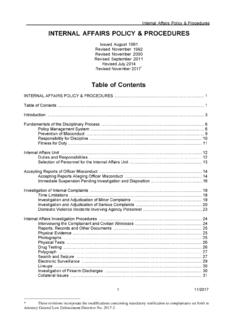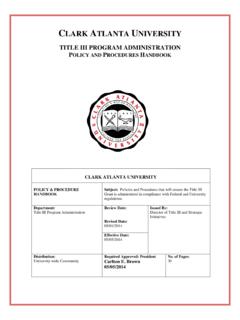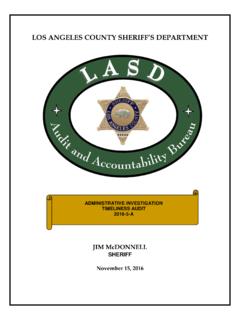Transcription of INTERNAL CONTROL GUIDANCE: HUMAN RESOURCES I. …
1 INTERNAL CONTROL guidance : HUMAN RESOURCES . I. Leave Reporting Area of Risk: Leave Reporting Description of Risk: Improper compensation could result from inaccurate vacation sick leave record keeping, which may be immaterial individually, but material for the Institute as a whole. Criteria: The Institute's Policy Library, Employment, entitled Time Away From Work contains descriptions and policies regarding types of leave available to employees at Auditor's Overview: The purpose of reviewing this area is to ensure that campus units have in place a system that ensures accuracy of vacation and sick leave by all applicable employees. Best Practices: 1. Communicate the Institute's leave reporting practices to the unit employees; training RESOURCES are available at 2.
2 Designate an individual (and alternates) within the unit the responsibility for overseeing the leave reporting process 3. Verify and/or ensure accuracy of the unit employees' reporting relationships; if modifications are needed, contact 4. Ensure supervisors acknowledge/approve monthly time reported by unit employees 5. Notify individuals who have not reported their monthly leave balances 6. Time Reporting policy and necessary forms for hourly paid employees are available at: Process: SET THE TONE AT THE TOP. We recommend the unit head ensure faculty and staff understand their responsibilities regarding monthly leave reporting. This may be accomplished by composing, approving, and distributing written policies and procedures INTERNAL to the unit. REPORTING.
3 OHR launched a new leave management system, TimeOut. The system provides monthly-paid faculty and staff an online system to request and report vacation, sick, paid military leave, consulting and court leaves. Employees are required to submit their monthly time report even if they did not take any time off. Supervisors can electronically approve and view employees' leave report, correct leave reports and verify leave. Employees can access TimeOut through Techworks Related Issue: Termination/Retirement: Remember when an employee resigns or retires, payments for accrued vacation leave or credit for sick leave are to be based on the official Institute leave balance as supported by TimeOut. II. Off-Campus Assignments Area of Risk: Off-Campus Assignments Description of Risk: Failure to comply with Board of Regents, and Institute Policies and Procedures regarding off-campus assignments could subject the Institute to risk of loss by compensating employees for activities that are not conducted in the best interest of the Institute, and could result in negative publicity.
4 Criteria: The Board of Regents (BOR) Academic and Student Affairs Handbook, Section , discusses Educational and Professional Leave : Institute policy on Professional Absence and Leave Policies contains detailed policy for faculty: policies Auditor's Overview: The purpose of reviewing this area is to ensure that campus units have in place a system that ensures that off-campus assignments are reported, documented, approved in advance, and monitored. Best Practices: 1. The Unit Head communicates, in written policies and procedures, the INTERNAL process for acceptable documentation and approval of absences from the campus for professional and other activities. 2. All faculty and staff members should be aware of Board of Regents and Institute policies and procedures regarding off-campus assignments.
5 Periodic reminders during faculty and staff meetings will serve to reinforce Board of Regents policies and procedures. Process: DEVELOP AND EXECUTE INTERNAL PROCESS FOR PROFESSIONAL LEAVES OF. ABSENCES. Responsible unit staff should familiarize themselves with Board of Regents and the Institute's policies and procedures pertaining to professional leaves of absences. The unit should communicate to employees, on a periodic basis, the Institute's policy pertaining to professional leaves of absences. This may be accomplished through reminders at faculty/staff meetings, correspondence with employees, or unit INTERNAL procedure manuals. A designated person in the unit should establish a procedure to ensure the receipt of all requests for professional leaves of absences.
6 The designated person should ensure that the unit obtains required approvals of professional leaves of absences and that such approvals are documented within the unit. III. Employment Eligibility Verification Area of Risk: Employment Eligibility Verification Description of Risk: Failure to complete and maintain required documentation for employees of the Institute could subject the Institute to fines and penalties imposed by the Immigration and Naturalization Service, a hold put on hiring of non-resident aliens, as well as adverse publicity. These documents are subject to review during Department of Labor, Office of Federal Contract Compliance Programs audits. Criteria: The Immigration Reform and CONTROL Act of 1986 require employers to verify the identity and employment eligibility of anyone hired after November 1986.
7 It is unlawful to knowingly hire, or to continue to employ, any individual not authorized to work in the Form I-9, Employment Eligibility Verification, was developed for verifying that persons are eligible to work in the United States. Institute requirements call for a new employee to complete Form I-9. on the first day of employment and present required forms within the first three days of employment. Also, policy requires the tracking of expiration of employment authorization documents held by non-resident aliens. Institute hiring departments are responsible for advising new employees of the time frame and documentation required to complete or update Form I-9s. Auditor's Overview: The purpose of reviewing this area is to ensure that campus units advise new employees of the need to contact HUMAN RESOURCES to complete Form I-9, Employment Eligibility Verification, before they work in the unit.
8 Best Practices: 1. The Unit Head empowers one person with the responsibility and authority to advise new employees regarding the completion and updating of Form I-9, entitled Employment Eligibility Verification. 2. The appointed administrator advises new employees that they are to report to HUMAN RESOURCES to complete required paperwork, including Form I-9, before they are permitted to work in the unit. 3. The appointed administrator establishes the appropriate contact with the Office of HUMAN RESOURCES in order to be informed on the tracking of expiration of employment authorization documents held by non-resident aliens in the unit. The unit administrator advises applicable personnel of the need to update Form I-9s. Process: EMPOWER THE PEOPLE RESPONSIBLE.
9 The Unit Head appoints a person within the unit to ensure compliance with the Immigration Reform and CONTROL Act of 1986, which requires employers to verify the identity and employment eligibility of new employees. EXECUTION OF POLICIES AND PROCEDURES. The appointed administrator should put in place a process to ensure compliance with the Immigration Reform and CONTROL Act. Some tasks an administrator might do to implement a compliance process are: Familiarize him/herself with the New Hire Documents on OHR website: Formalize approach for assuring compliance with Form I-9 procedures Communicate procedures to staff, as applicable Communicate Form I-9 requirement to staff in pre-employment correspondence and when they initially report to the unit Establish lines of communications with the Office of HUMAN RESOURCES in order to track and notify non-USA citizens of the expiration of work authorization documents and the need to update Form I-9s IV.
10 Sexual Harassment Area of Risk: Sexual Harassment Description of Risk: Sexual harassment can (1) alienate employees, (2) create a hostile work environment, (3) result in lawsuits, fines, and penalties for violations; and (4) cause adverse publicity. Criteria: It is the policy of this Institute that no member of its community, including administrators, faculty, staff, or students, should be subjected to sexual harassment by another. This policy and procedure is intended to create an atmosphere in which individuals who believe that they are the victims of harassment are assured that their complaints will be dealt with fairly and effectively. Toward this end, the Georgia Institute of Technology supports the principle that sexual harassment represents a failure in ethical behavior, and that sexual exploitation of professional relationships will not be condoned.




